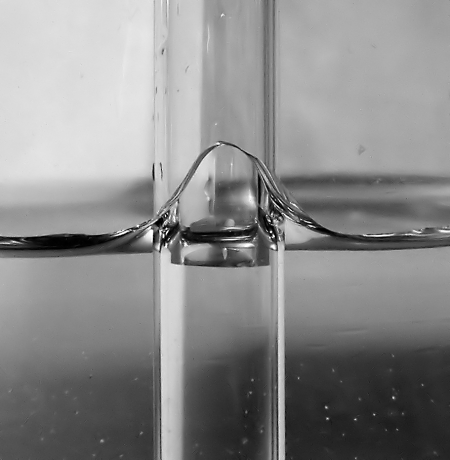

 and
the other contains 1 M NaOH (<em>aq.</em>
and
the other contains 1 M NaOH (<em>aq.</em> . You are provided a 10 cm
length of plain borosilicate glass tubing with a circular cross-section (average diameter/bore, not capillary), flame-polished on both ends, to do
with as you please. You are asked to determine which beaker contains which solution.<hr />
. You are provided a 10 cm
length of plain borosilicate glass tubing with a circular cross-section (average diameter/bore, not capillary), flame-polished on both ends, to do
with as you please. You are asked to determine which beaker contains which solution.<hr />


 . I thought of this, but am not exactly sure it would work. Perhaps someone could actually perform this experiment (1
M solutions!) and record a video for us. I also came up with the glass wetting solution—quite elegant, nice work! I did think of trying to
powder the glass by grinding on the table, but did not think of snapping the tube and using the break to score the other piece. That should work.
Wonderful.
. I thought of this, but am not exactly sure it would work. Perhaps someone could actually perform this experiment (1
M solutions!) and record a video for us. I also came up with the glass wetting solution—quite elegant, nice work! I did think of trying to
powder the glass by grinding on the table, but did not think of snapping the tube and using the break to score the other piece. That should work.
Wonderful. </li><li>adherence to glass (wetting)</li><li>exhaling into solution (several variants)</li><li>refraction of
light (Endimion17's suggestion was close enough)</li><li><!--dissolve hair-->???</li><li><!--drink
one-->???</li><li><!--'bead'-->???</li><li><!--viscosity-->???</li><li><!--ask
technician-->???</li><li type="circle">vertical displacement by CO<sub>2</sub> absorbtion (nice one,
kuro96inlaila!)</sub></ol>
</li><li>adherence to glass (wetting)</li><li>exhaling into solution (several variants)</li><li>refraction of
light (Endimion17's suggestion was close enough)</li><li><!--dissolve hair-->???</li><li><!--drink
one-->???</li><li><!--'bead'-->???</li><li><!--viscosity-->???</li><li><!--ask
technician-->???</li><li type="circle">vertical displacement by CO<sub>2</sub> absorbtion (nice one,
kuro96inlaila!)</sub></ol> ) in order to get some ammonia. Then take a drop of liquid from both beakers and
keep that above the old pee with the ammonia smell. The HCl will give off faint smoke, the NaOH does not. The reaction will not be strong with 1 M
HCl, but one definately can see faint smoke of NH4Cl.
) in order to get some ammonia. Then take a drop of liquid from both beakers and
keep that above the old pee with the ammonia smell. The HCl will give off faint smoke, the NaOH does not. The reaction will not be strong with 1 M
HCl, but one definately can see faint smoke of NH4Cl.
 </li><li>adherence to glass (wetting)</li><li>exhaling into solution (several variants)</li><li>refraction of
light (Endimion17's suggestion was close enough)</li><li>dissolve hair (Diablo suggests NaOH straightening curly
hair)</li><li><!--drink
one-->???</li><li><!--'bead'-->???</li><li><!--viscosity-->???</li><li><!--ask
technician-->???</li><li>urinate on table/in beakers (leave it to woelen...)</li><li type="circle">vertical displacement by
CO<sub>2</sub> absorbtion (nice one, kuro96inlaila!)</sub></ol>
</li><li>adherence to glass (wetting)</li><li>exhaling into solution (several variants)</li><li>refraction of
light (Endimion17's suggestion was close enough)</li><li>dissolve hair (Diablo suggests NaOH straightening curly
hair)</li><li><!--drink
one-->???</li><li><!--'bead'-->???</li><li><!--viscosity-->???</li><li><!--ask
technician-->???</li><li>urinate on table/in beakers (leave it to woelen...)</li><li type="circle">vertical displacement by
CO<sub>2</sub> absorbtion (nice one, kuro96inlaila!)</sub></ol>


Quote: Originally posted by neptunium  |
| Quote: |
 ) and add some to each of the beakers. IIRC, the HCl will go red, and the NaOH
yellow/green?
) and add some to each of the beakers. IIRC, the HCl will go red, and the NaOH
yellow/green?Quote: Originally posted by Eddygp  |